Fiorentina have had a decent start to the Serie A season with four wins and four draws to their name. This helped the club rise up to the ninth position on the league table and revived their hope of returning to European football after a disastrous 2018/19 season which saw them finished 16th. The squad that Vincenzo Montella has built for this season is a combination of young prospects with experienced names that have enjoyed the beautiful game for seasons.
The combination of Franck Ribéry and Federico Chiesa up front has played a very important part in the team’s attacking play as they contributed in a total of eight goals and that takes up 44.4% of the team’s overall record. At the same time, Nikola Milenković and Germán Pezzella brought solidity at the heart of Fiorentina’s defence and the former even managed to get himself three goals. But running the midfield for Montella’s side this season is Gaetano Castrovilli, who has been impressing in the recent matches and received the call-up to the Italian national team.
This tactical analysis scout report will provide an analysis of Castrovilli’s style of play and find out why he has been so impressive this season. Meanwhile, using statistics and footages, we will point out his influence on the team’s tactics and forecast his future with Fiorentina.
Overview and style of play
Castrovilli eventually joined Fiorentina from Bari in the 2017/18 season after being impressive in his loan spell a season earlier. After two seasons going on loan at Cremonese in Serie B, he is now ready to challenge for a key player spot at the club.
After a few inconsistent matches at the start of the season, Fiorentina are now getting on track and one of the factors that will become crucial later on is the player’s familiarity with the formation and system. In Montella’s 3-5-2 formation, Castrovilli is used as a left-sided central midfielder more often this season but his versatility doesn’t stop there.
Throughout his career, he has been used in various positions and is able to play in almost every role in midfield. Furthermore, he has had 27 matches playing as a winger on both wings and three matches in the role of a second striker. This will give Montella the flexibility in how he lines his team up for the upcoming matches and allow Castrovilli to fill in different spots on the field when the manager required.
Looking at the spot that he is currently occupying, it seems like he is taking up a more dynamic role in Fiorentina’s midfield three since he is being paired up with Erick Pulgar, who carries more defensive duties in the role that the Chilean is fulfilling. At the same time, Marco Benassi and Milan Badelj are doing the dirty and unfuzzy work at the centre of the midfield, allowing Castrovilli to drive forward more often.
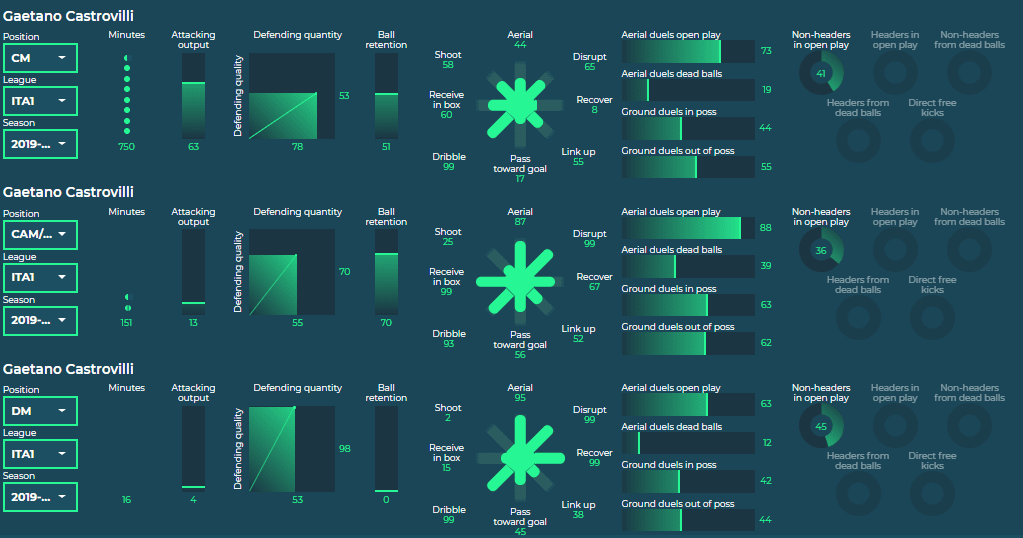
Attacking contributions
As mentioned earlier, Castrovilli is currently occupying the role of a dynamic, left-sided midfielder in Fiorentina’s midfield-three. But dynamic seems like a very general term to point out the role that he is currently responsible for and it is worth taking a closer look at his responsibilities and duties on the pitch.
When the team is in possession, the players usually put an emphasis on playing out from the back and progress the ball up the field through the midfielders. While three centre-backs have the tendency of staying quite close to each other, two of the central midfielders will drop deep to screen the space in front of them and offer to pick the ball up. Castrovilli isn’t an exception, either, as he also involves in several similar situations where he receives the ball from Milenković or Martín Cáceres and then drives forward.
As he attempts to do so, he tends to scan the space first to look out for pockets of space where he can position himself into. This allows the centre-backs to find him easier and also creates time and space for him to execute the next move. At times, it is possible to look out for attackers who sit on the shoulder of defenders and he will immediately send them a through ball to start the attack. A quick transition move that being executed quite often this season and Fiorentina have benefitted from a few of those by creating dangerous chances towards the opposition’s goal, similar to the situation below against Sampdoria.
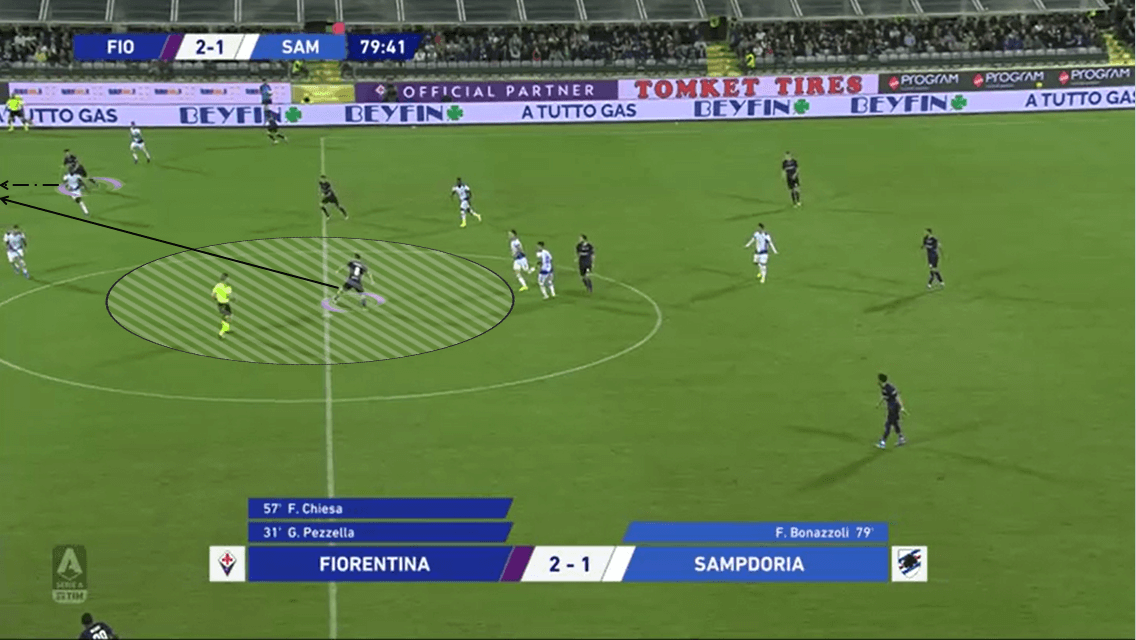
In situations where he is able to bring the ball out of defence, Castrovilli doesn’t hesitate to link up with his teammates and creates passing triangles all across the opposition’s half. He would look for players surrounding him by stopping the play for a few seconds then use one-two combinations to progress the ball up the pitch.
At the same time, intelligent movements and understanding his teammates are also required to keep the attack moving. It also confuses the opposition’s defenders in their attempt to track the movement of the ball while still maintaining Fiorentina players in their sight. The situation below is a perfect example of how Castrovilli links up with Pulgar using a one-two pass and capitalised on Chiesa’s movement to enter the space behind Lazio’s defender, Senad Lulić’s back.
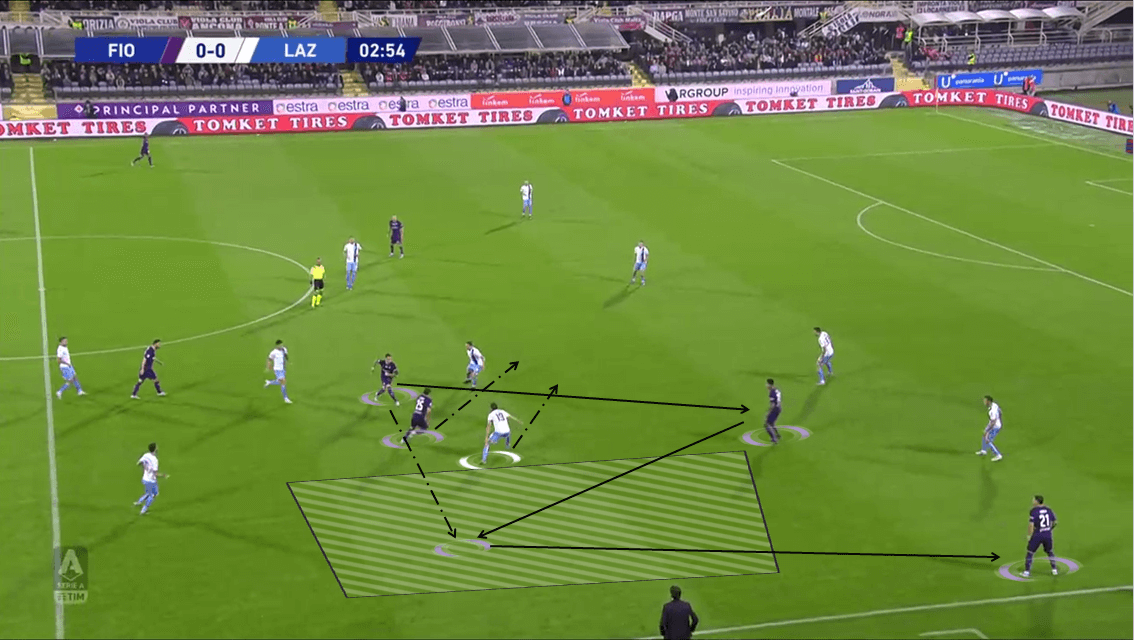
Making short passes to link up with his teammates is a part of his game and it helps the team to recycle possession more effectively. But at times, long balls can be very effective when Fiorentina attempt to create counter-attacks. Also, when playing against teams who line up in a low-block, long-range passes is useful to break down defensive lines and open up space for the wing-backs to overlap into.
Using his vision and decision-making ability, Castrovilli is able to create direct passes towards both flanks to invite the likes of Riccardo Sottil, Dalbert or Pol Lirola to join the attack. Long pass is one option that Castrovilli uses to distribute the ball wide, but he also makes through balls into the wing-back’s run to allow him continuing his progressive movement. Since Fiorentina are a wing-oriented team, this strategy is used quite often to exploit space out wide and allow the attackers to attack the space behind the opposition’s defensive line.
On average, he registers 35 passes per game with an accuracy rate of 81.7%. Those numbers seem to be pretty good for a midfielder who usually focuses on his movements, but compared to the rest of the squad, he only sits eighth on the table. With 48.2 (88.2%), 47.5 (85.3%), 46.5 (84.6%) passes per game, Milenković, Cáceres and Pezzella currently occupy the top three spots respectively. Below them are Castrovilli’s colleagues in Badelj and Pulgar as they register 45.7 (82.5%) and 43.9 (85%) passes per game. It is quite clear to notice a big gap between the top five players (who play more than ten matches) and Castrovilli, which highlights how heavily Fiorentina put an emphasis on playing out from the back.
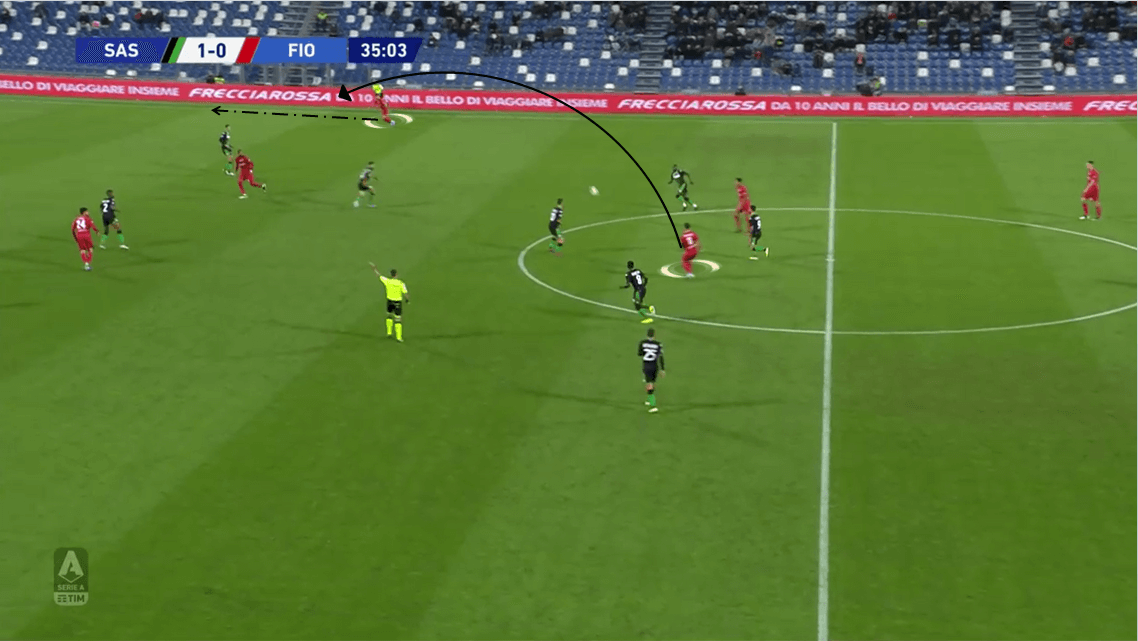
Two of Castrovilli’s standout attributes that he constantly shows this season are his positioning and spatial awareness. In the first example that we analysed, it was not simple to pick out a pocket of space where he could connect with the centre-backs to receive the ball, especially when Sampdoria usually applied pressure on them. But by staying close to each other, the centre-backs managed to reduce the riskiness among their passes and even lured the attackers up to create space behind his back. That is when the former Bari midfielder stepped in and made the most out of that space.
As a midfielder who tends to roam more from his position, Castrovilli usually finds himself playing slightly on the left, which is shown on his heatmap this season. This also switches Fiorentina’s original formation from a 3-5-2 into a 3-4-2-1 with Chiesa leading the line and Ribéry playing slightly lower. On several occasions where the team attack down the left-hand side, it is easy to spot the midfielder positions himself in between the lines.
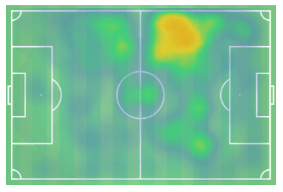
The aim of this is to allow him to attack the space behind the midfielders’ back, similar to the situation below. Obviously, when Fiorentina’s ball carrier drives forward with the ball, he will attract the attention of the midfielders.
At the same time, the opposition will also try to mark the players surround that area and this required them to move away from their position. By staying in between the lines, Castrovilli can drop deep to enter the space being created and pick up the ball from the ball carrier. In this situation, he managed to make a “round-the-corner” turn to bypass Lucas Leiva’s pressure and struck a shot that went wide.
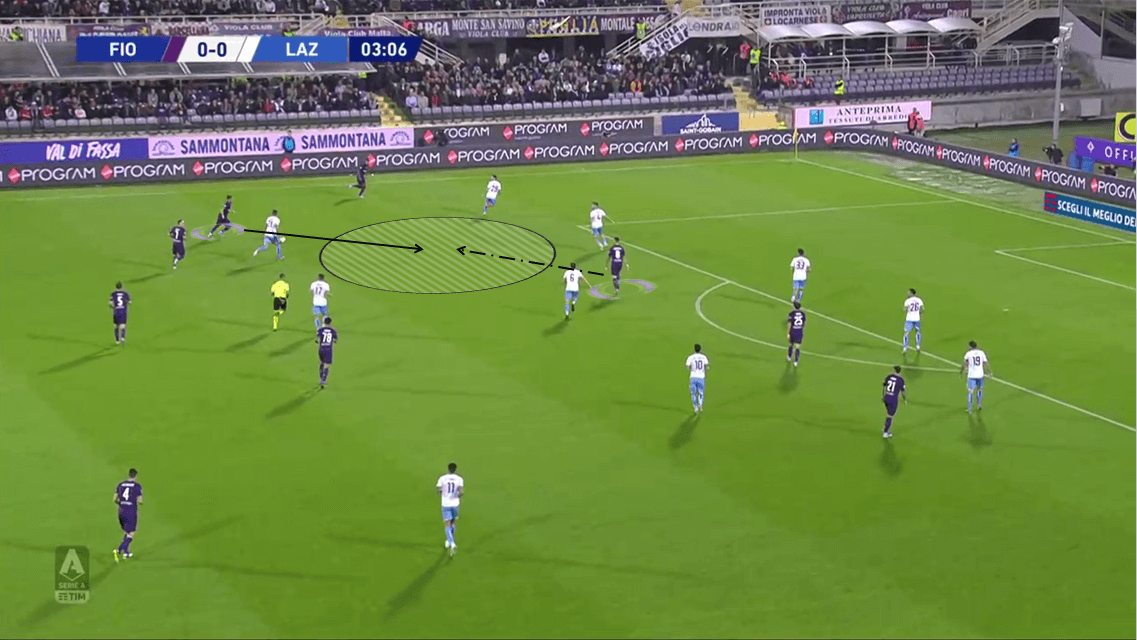
Not only does he shows his positional awareness and decision-making around the 16-yard box to help him receive passes, but he also demonstrates it when it comes to picking a perfect spot to turn up at the end of crosses. Predicting the direction of crosses seems like a hard thing to do as it depends on the force being put on the ball and where it would drop. But Castrovilli already has two goals from crosses against Sassuolo and Parma.
In both situations, Fiorentina’s opponents had many players occupying the near post and only left one or two players marked the far post. Just before the cross came in, Castrovilli had already found himself a place to receive the ball and even managed to notice the space where he could enter to make a rebound if the keeper could not gather the ball properly.
This was the factor that helped increase the possibility of scoring for the Fiorentina’s midfielder as he would have another attempt to threaten the goal in case the first one was stopped. Fortunately, though, both of his headers were out of the keeper’s reach to help his team got back into the game after being trailed.
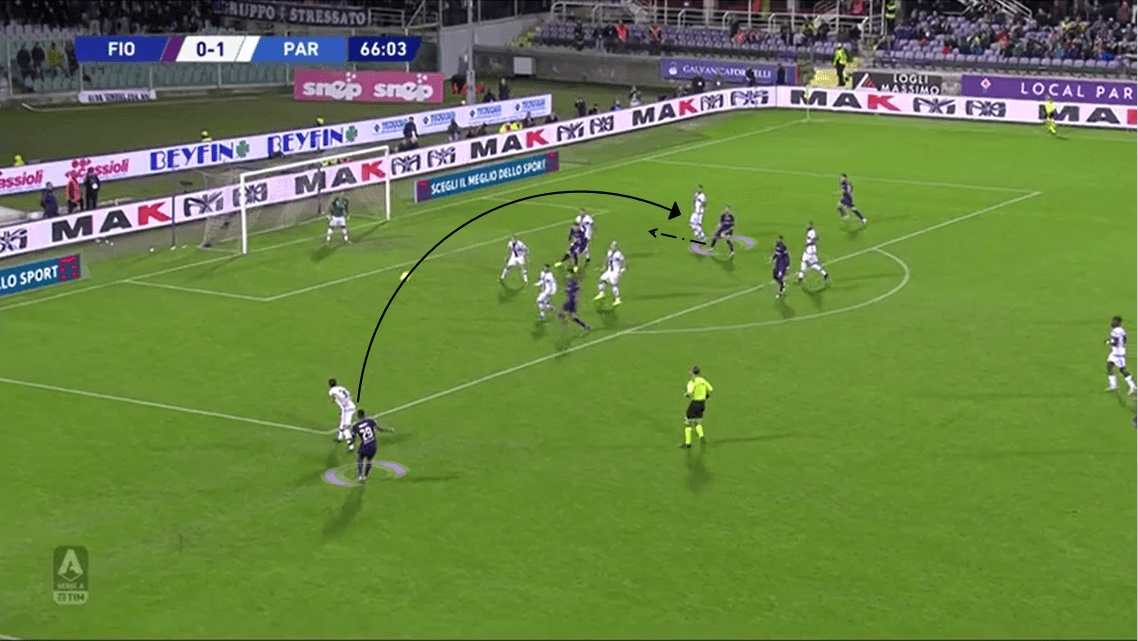
Another advantage of playing slightly to the left is he will be allowed to use more of his right foot, which is also his preferred foot. There, working more inside the left half-space is something that he likes to do to maximise the ability of being a right-footed player and also leave the wide space for Dalbert to overlap. That doesn’t mean Castrovilli doesn’t use his left foot, though. He is competent using his weaker foot but doesn’t use it very often. Only in situations where the former Cremonese midfielder has space to keep possession, he would use his left foot to direct passes towards his teammates. A different scenario where we can find him utilise it is when he has a first-touch to control the ball. Other than that, the tendency of using his weaker side is quite rare as it would reduce the quality of his move and can even force him to lose possession.
Castrovilli also tends to arrive late in the final third, which allows him to have a clear perspective on the attacking situation. As he enters the box, slowing down is his option to notify the position where he can offer to receive the ball. When the opposition focus on swarming the central area of the box, they will leave the wide-area vulnerable and the Fiorentina’s midfielder will locate himself there.
He perfectly demonstrated the mentioned scenario in the game against Sassuolo. With the opposition’s defenders swarmed zone 14 and the edge of the box, they left a big gap on the right-hand side for Castrovilli. After Chiesa shook off the pressure from Alfred Duncan, a through ball was made into the midfielder’s run and allowed him to find Milenković on the far post.
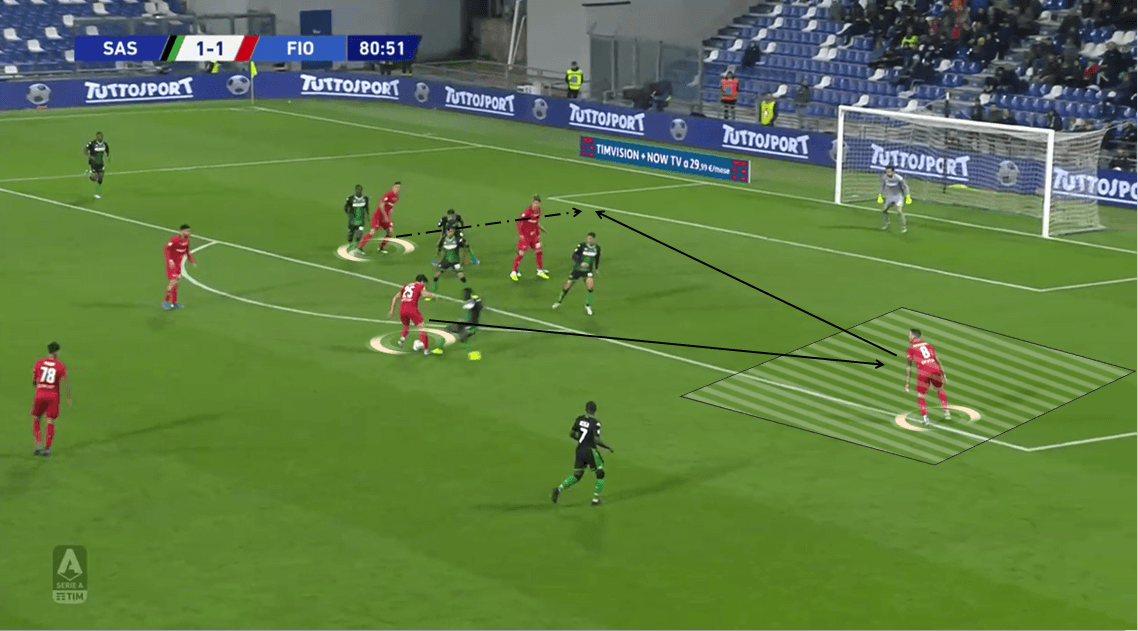
As good as Castrovilli is when passing the ball, dribbling is also another attribute that really stands out. He is described as a pacey player, which is true as the Fiorentina midfielder has the speed to beat his marker and enter the final third. Along with a small technical move, this helps him getting past the defender more easily while creating more time for him to scan for potential receivers.
Being confident when driving forward with the ball is also a key factor as if not then he would choose the option of staying in his position and just circulating the ball around. It will become a major setback for the team’s attacking play since the progressing process keeps getting hindered by one player. In contrast, though, Castrovilli is usually be seen scanning for space before bypassing his marker and then executing his move. The situation below against Brescia demonstrates what being analysed as the midfielder entered the space behind the opposition’s defensive line after bypassing one of their midfielders. This forced the defenders to track back and defend the box, therefore, widening the gap to allow more Fiorentina players to move into.
Surprisingly, his dribbling stats currently helps him occupying the top spot among the squad and the seventh spot compared to the rest of the league. He currently registers a total of 76 dribbles with the completion rate of 65.9%. That is five dribbles more than Chiesa’s record and thirteen less than leader Riccardo Orsolini’s. But in terms of the average number per 90, he only places 17th in the league with 6.24 per 90. Generally speaking, though, the numbers do show how he likes to dribble on the ball more often and it also helps bringing his teammates into play.
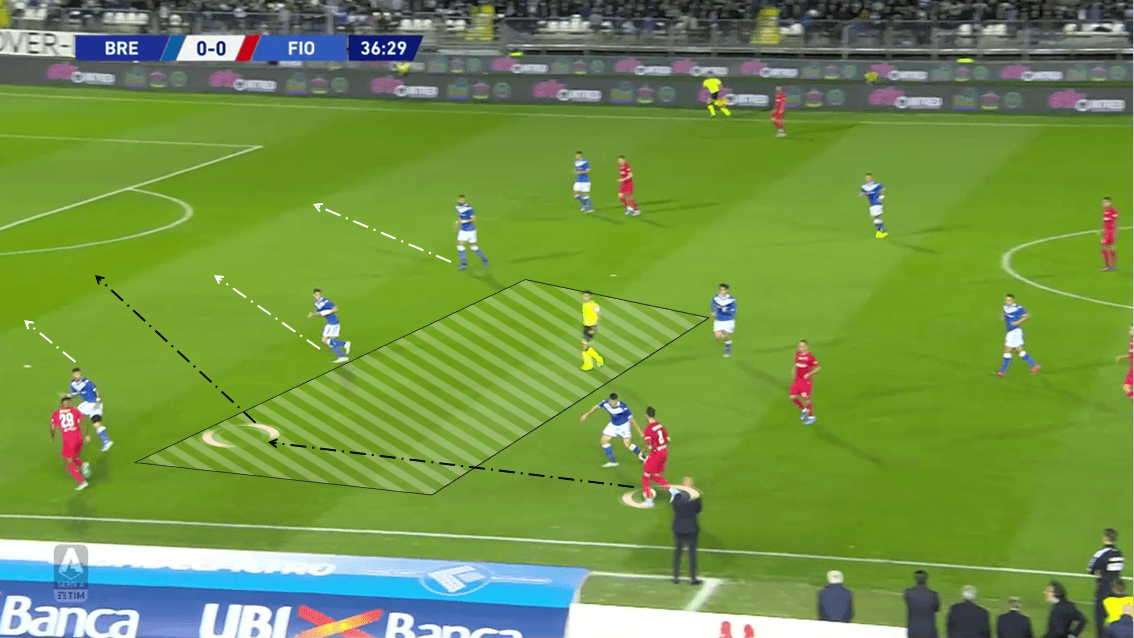
His role in defensive situations
Usually positioning himself in between two strikers and the midfielders, Castrovilli takes up the responsibility of supporting Chiesa and Ribéry in pressing the opponent. The three players can flexibly change their markers based on the ball’s direction and the opponent’s formation.
When playing against a back-four, Chiesa and Ribéry will press a centre-back and a full-back while Castrovilli moves higher to press the other centre-back. They can switch with each other as the midfielder will drift wide to allow one of the strikers to move centrally. Against a back-five, they apply pressure on all three centre-backs to cut passing lanes between them while forcing them to make long balls up the pitch.
A trait that can be seen when he presses is he usually suffocates space surround the ball carrier. In this situation below, Castrovilli followed the Lazio wing-back Manuel Lazzari to the edge of the 16-yard box and screened the space behind him in case of a pass towards central midfielder Sergej Milinković-Savić or goalkeeper Thomas Strakosha. And although centre-back Francesco Acerbi came near offering to pick the ball up, the Fiorentina midfielder already squeezed the space to force Lazzari made a misplaced pass.
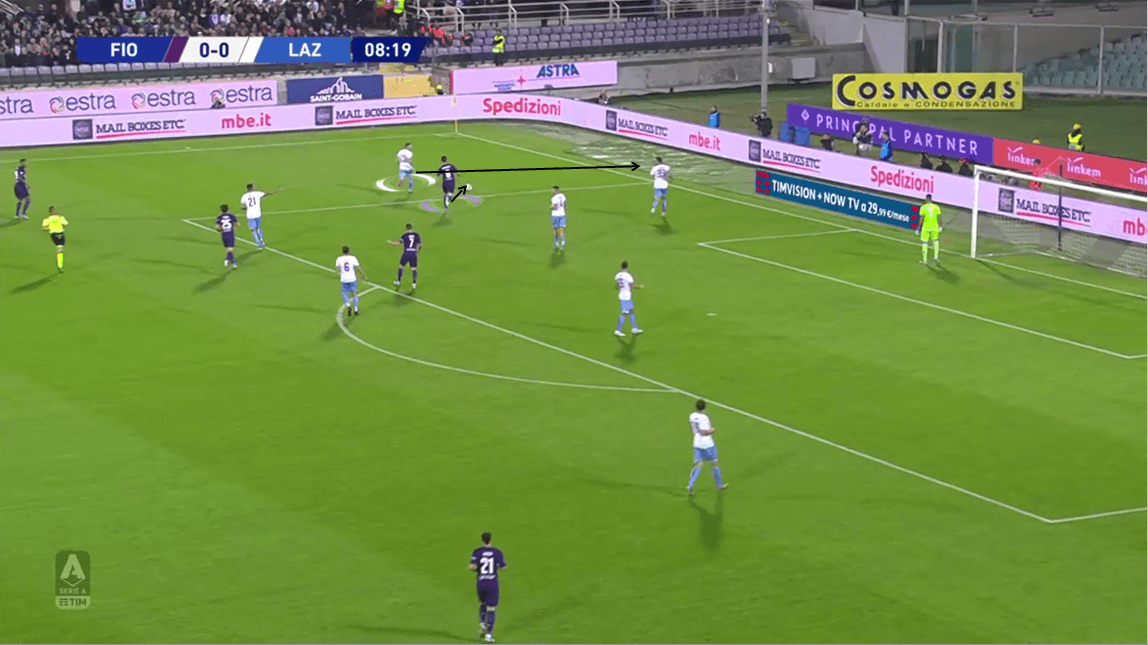
One thing to note about the situation above is if not for Castrovilli’s pace, which is one of his strongest attributes, he would not be able to catch up with Lazzari and the former SPAL midfielder would still make a pass to Acerbi. This shows how speed plays a very important role in both his attacking and defending style of play.
Although starting at a deeper position compared to the ball carrier, he can still sprint towards him to close the space surround the ball carrier down, similar to the shot below. At the same time, it is even viable for him to force the player to make a heavy touch by applying pressure on him and he will accelerate towards the ball to regain possession for Fiorentina.
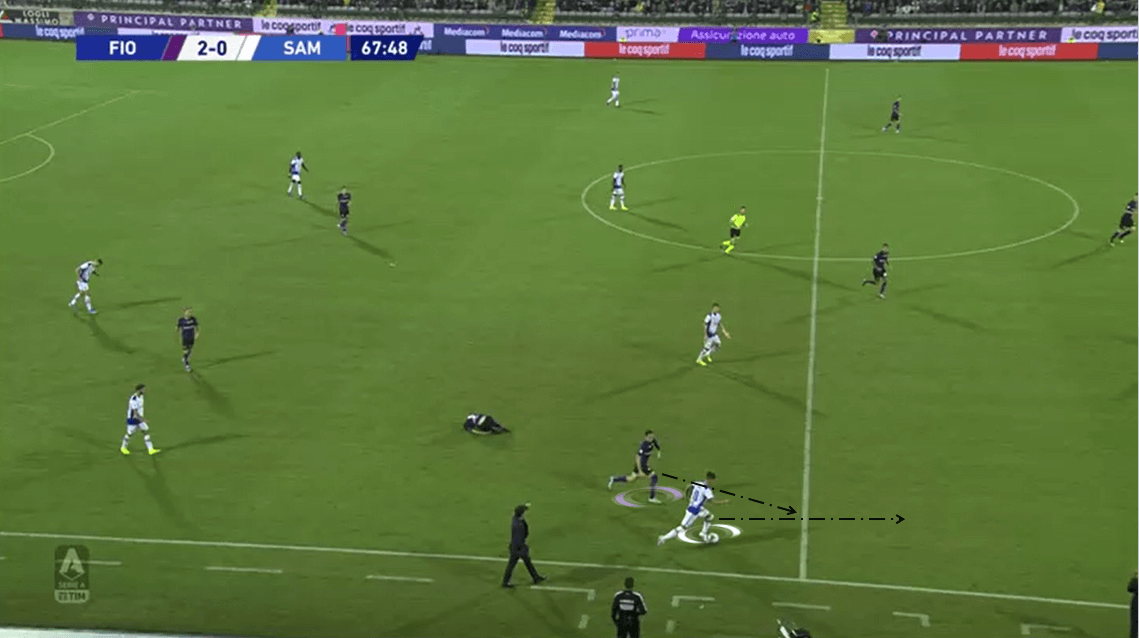
Being a pacey player also gains him an advantage in marking the opposition’s player, which is a crucial factor that benefits the team’s defence in general. As he retreats from his attacking position, he will find a player who attempts to offer a passing option or position himself on the shoulder of defenders.
In that case, his pace will help him catch up with the mentioned player while still keeping him in his sight. If that player executing his intention then sprinting towards him is the most viable option to intercept the pass or cross and start an attack for the team. Otherwise, he keeps a moderate distance to that player and constantly maintaining him in sight until one of his teammates takes on that responsibility. With almost three interceptions per 90 minutes, this indicates how well he makes the most out of his ability to help his teammates in the team’s defensive situations.
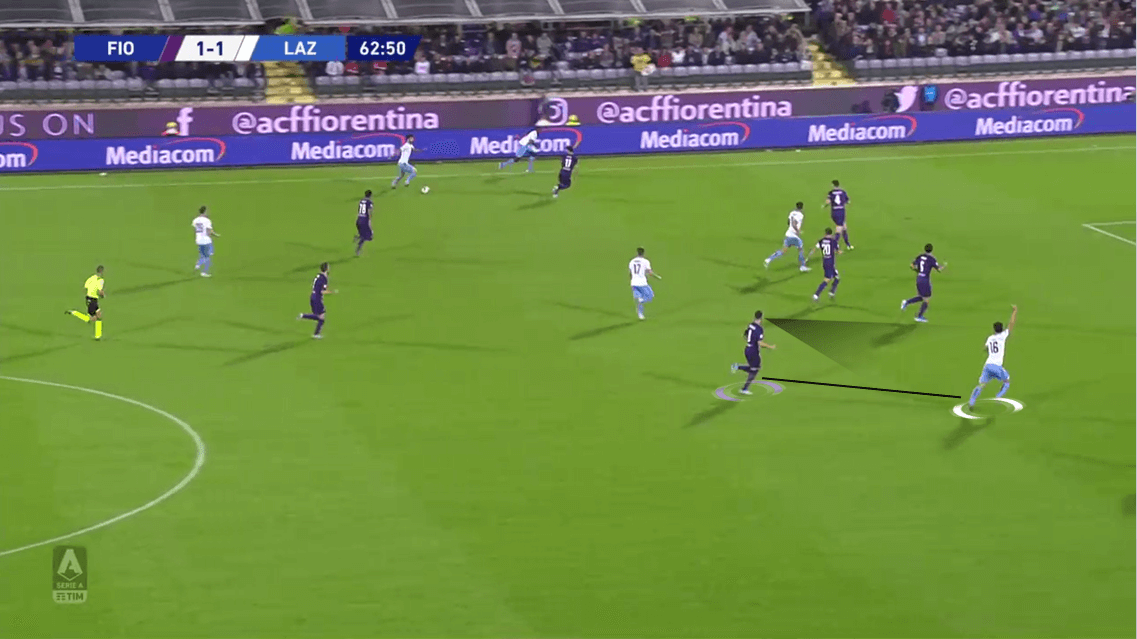
Registering two tackles per game and 0.74 of them are sliding tackles shows that he is the type of player who usually dives into tackles. On several occasions, making a tackle is his option to intercept a pass as he doesn’t manage to recover on time, similar to the shot below. As he noticed Ciro Immobile took some time to orientate his body for receiving the pass, his tackle helped him reached the ball first and cleared it.
Another reason to explain why he tends to dive into tackles is he lacks the physicality to involve in 1v1 duels with the opposition’s attacker. Although this is an acceptable reason, there are signs that he is overusing it which can lead to a poor discipline record. After the first twelve matches, he already has two fouls to his name, which is a warning sign given the fact that five yellow cards were shown and he will miss Fiorentina’s next match against Hellas Verona.
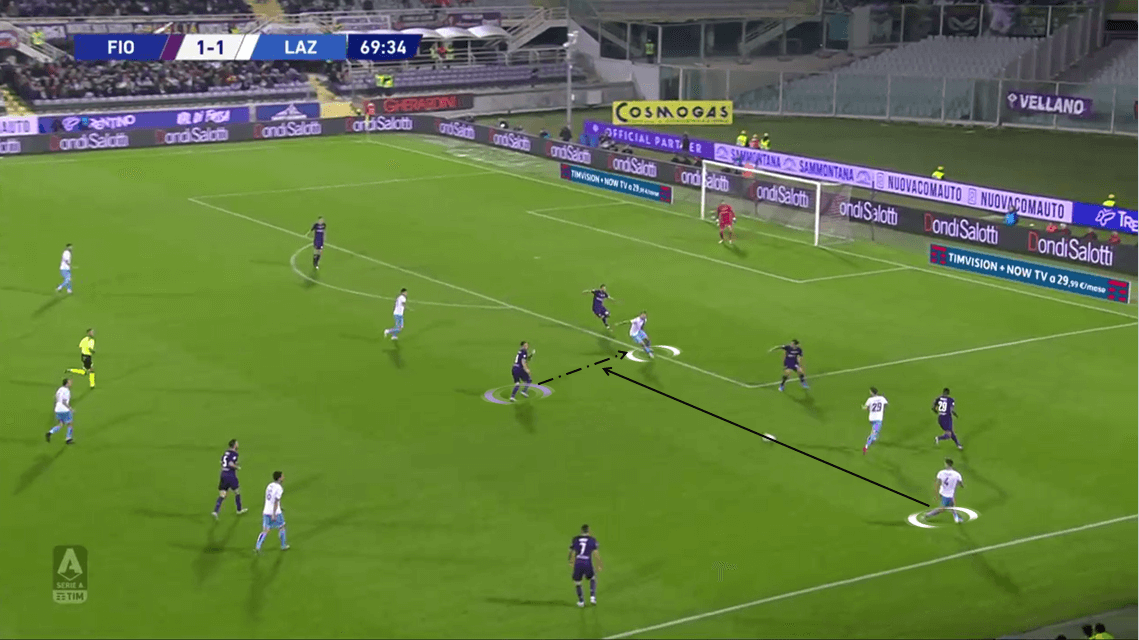
Conclusion
Making a step up from Serie B to Serie A is never easy, especially when playing for one of the strong teams in the top league. Having enjoyed two consecutive seasons in the second-highest division with Cremonese, Castrovilli hasn’t shown signs of being overwhelmed by his new surroundings. He even thrived under pressure and is now one of Montella’s first choices for his team.
In the role of a roaming playmaker, he is the heartbeat of the team in their attacking situations through his dribbles and key passes. Flexible use of his pace and positioning allows him to receive passes from his teammates and also intercepts them from the opposition. Only one minor setback that he needs to improve on is his discipline, but other than that, he looks destined to continue his impressive form in Serie A for Fiorentina and heading for his second match for Azzurri.

If you love tactical analysis, then you’ll love the digital magazines from totalfootballanalysis.com – a guaranteed 100+ pages of pure tactical analysis covering topics from the Premier League, Serie A, La Liga, Bundesliga and many, many more. Buy your copy of the November issue for just ₤4.99 here





Comments